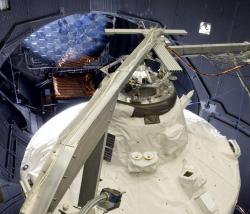 ESA’s new Automated Transfer Vehicle, Jules Verne, has recently spent 21 days in a chamber that simulated the cold, radiation and vacuum of space. And it passed with flying colours. The 20-tonne spacecraft will eventually be attached to the top of an Ariane 5 rocket in the summer of 2007, and flown to the International Space Station. A whole fleet of these spacecraft will eventually be built, transferring replacement cargo to the station, and then serving as disposable garbage cans, burning up in the Earth’s atmosphere.
ESA’s new Automated Transfer Vehicle, Jules Verne, has recently spent 21 days in a chamber that simulated the cold, radiation and vacuum of space. And it passed with flying colours. The 20-tonne spacecraft will eventually be attached to the top of an Ariane 5 rocket in the summer of 2007, and flown to the International Space Station. A whole fleet of these spacecraft will eventually be built, transferring replacement cargo to the station, and then serving as disposable garbage cans, burning up in the Earth’s atmosphere.
Continue reading “Jules Verne Spends 21 Days in Space, Here on Earth”
Venus Express Looks Right Down to the Surface
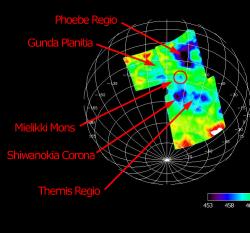 Looking down through Venus’ thick cloud cover isn’t easy work. That’s why ESA’s Venus Express was equipped with the Visible and Infrared Thermal Imaging Spectrometer (VIRTIS) instrument. It allows the spacecraft to see infrared spectral windows that appear in the planet’s atmosphere. These allow heat radiated by the hot rocks on Venus’ surface to reach space, and Venus Express’ instruments. The VIRTIS team hopes to eventually use this technique to see mysterious hot spots on the surface of Venus that could be active volcanoes.
Looking down through Venus’ thick cloud cover isn’t easy work. That’s why ESA’s Venus Express was equipped with the Visible and Infrared Thermal Imaging Spectrometer (VIRTIS) instrument. It allows the spacecraft to see infrared spectral windows that appear in the planet’s atmosphere. These allow heat radiated by the hot rocks on Venus’ surface to reach space, and Venus Express’ instruments. The VIRTIS team hopes to eventually use this technique to see mysterious hot spots on the surface of Venus that could be active volcanoes.
Continue reading “Venus Express Looks Right Down to the Surface”
New Technique Could Reveal Dark Matter
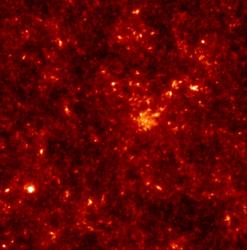 Dark matter is invisible to all our instruments, but that doesn’t mean it isn’t there. It does reach out to regular matter with its gravity. A new technique being developed at the Max Planck Institute for Astrophysics might be able to make dark matter reveal itself. A large enough radio telescope should be able to map the radiation from pregalactic hydrogen – formed shortly after the big bang, and visible in all directions. Any intervening dark matter will distort this radiation, like ripples in a pond, revealing its presence and quantity.
Dark matter is invisible to all our instruments, but that doesn’t mean it isn’t there. It does reach out to regular matter with its gravity. A new technique being developed at the Max Planck Institute for Astrophysics might be able to make dark matter reveal itself. A large enough radio telescope should be able to map the radiation from pregalactic hydrogen – formed shortly after the big bang, and visible in all directions. Any intervening dark matter will distort this radiation, like ripples in a pond, revealing its presence and quantity.
Continue reading “New Technique Could Reveal Dark Matter”
Book Review: Making Every Pixel Count, Vol. 1-3
![]() Astronomy has many unfair advantages over the other natural sciences because it captures elements of travel, adventure and discovery. One glimpse through eyepiece filled with thousands of previously unseen stars has lured many casual observers into a head-over-heels love affair with the night sky that remains with them for the rest of their life. The dazzling images reproduced in magazines, books and movies also plant dreams of taking similar images in the minds of more than a few would-be astronomers, too! However, producing astronomical imagery is not for the feint hearted. It involves patience, perseverance and until very recently, a measure of luck. Much of that has changed with the introduction of computerized telescopes and affordable digital cameras. This year has also seen a small explosion of books and DVD tutorials that explain how to transform raw deep space images into picture postcards of the Universe!
Astronomy has many unfair advantages over the other natural sciences because it captures elements of travel, adventure and discovery. One glimpse through eyepiece filled with thousands of previously unseen stars has lured many casual observers into a head-over-heels love affair with the night sky that remains with them for the rest of their life. The dazzling images reproduced in magazines, books and movies also plant dreams of taking similar images in the minds of more than a few would-be astronomers, too! However, producing astronomical imagery is not for the feint hearted. It involves patience, perseverance and until very recently, a measure of luck. Much of that has changed with the introduction of computerized telescopes and affordable digital cameras. This year has also seen a small explosion of books and DVD tutorials that explain how to transform raw deep space images into picture postcards of the Universe!
Continue reading “Book Review: Making Every Pixel Count, Vol. 1-3”
Station’s Solar Panels Retracted Halfway
Shuttle astronauts spent a frustrating day today, trying to get the International Space Station’s solar wings retracted. NASA was hoping to retract the wings fully to allow new permanent solar panels to rotate to face the Sun and begin generating electricity. Astronauts did get the wings partially retracted; far enough to allow the larger wings to rotate, so NASA is considering the day a success. A spacewalk might be scheduled later in the week, for astronauts to manually assist folding the array.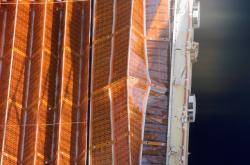
Continue reading “Station’s Solar Panels Retracted Halfway”
Finding Buried Craters on Mars
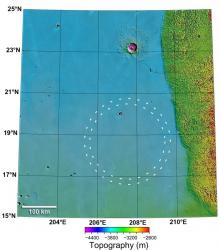 Many photographs have been taken of Martian landscapes, but now spacecraft are looking beneath the surface to see what’s buried underground. Researchers used instruments on board ESA’s Mars Express orbiter to detect ancient impact craters beneath the smooth surface of Mars’ northern hemisphere. Some of these craters were formed billions of years ago, but have been resurfaced and buried by lava flows and sediments from winds and water.
Many photographs have been taken of Martian landscapes, but now spacecraft are looking beneath the surface to see what’s buried underground. Researchers used instruments on board ESA’s Mars Express orbiter to detect ancient impact craters beneath the smooth surface of Mars’ northern hemisphere. Some of these craters were formed billions of years ago, but have been resurfaced and buried by lava flows and sediments from winds and water.
Continue reading “Finding Buried Craters on Mars”
Proton Launches MEASAT-3 Satellite
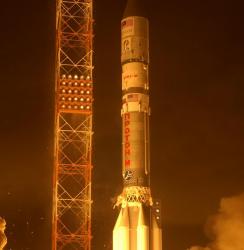 A Proton Breeze M rocket blasted off from the Baikonur cosmodrome on Monday, carrying a MEASAT-3 communications satellite into orbit. The launched at 23:28 UTC, and the satellite was released into a geosynchronous orbit 9 hours later. When it reaches its final orbit, MEASAT-3 will provide satellite broadcast and data services to customers in Southeast Asia.
A Proton Breeze M rocket blasted off from the Baikonur cosmodrome on Monday, carrying a MEASAT-3 communications satellite into orbit. The launched at 23:28 UTC, and the satellite was released into a geosynchronous orbit 9 hours later. When it reaches its final orbit, MEASAT-3 will provide satellite broadcast and data services to customers in Southeast Asia.
Continue reading “Proton Launches MEASAT-3 Satellite”
Detailed Ice Layers Revealed on Mars
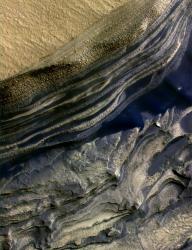 Amazing new images taken by NASA’s Mars Reconnaissance Orbiter show layers of ice deposits near the Martian poles. The polar layers are at the top of the image, while the darker materials at the bottom might have been deposited as sand dunes. The Martian ice has mixed with dust to give it the reddish hue.
Amazing new images taken by NASA’s Mars Reconnaissance Orbiter show layers of ice deposits near the Martian poles. The polar layers are at the top of the image, while the darker materials at the bottom might have been deposited as sand dunes. The Martian ice has mixed with dust to give it the reddish hue.
Continue reading “Detailed Ice Layers Revealed on Mars”
Watch for the Geminids on Wednesday
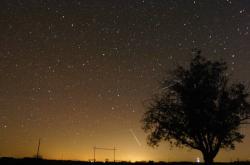 One of the best meteor showers of the year – the Geminids – are about to peak. If you’ve got clear skies, head out on the evening of December 13th, and you could see a few meteors an hour. Unlike most meteor showers, the source of the Geminids is a bit of a mystery, since the dust doesn’t seem to originate from a comet. A small asteroid called 3200 Phaethon has been discovered in the right orbit, but astronomers aren’t sure how it could be generating enough dust to cause such beautiful meteor showers.
One of the best meteor showers of the year – the Geminids – are about to peak. If you’ve got clear skies, head out on the evening of December 13th, and you could see a few meteors an hour. Unlike most meteor showers, the source of the Geminids is a bit of a mystery, since the dust doesn’t seem to originate from a comet. A small asteroid called 3200 Phaethon has been discovered in the right orbit, but astronomers aren’t sure how it could be generating enough dust to cause such beautiful meteor showers.
Continue reading “Watch for the Geminids on Wednesday”
First STS-116 Space Walk Wraps Up
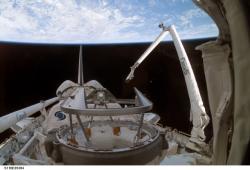 Construction is continued on the International Space Station today, when the crew of STS-116 went outside on their first spacewalk to attach the P5 truss segment. Bob Curbeam and Christer Fuglesang did the spacewalking, while Joan Higginbotham and Sunita Williams worked the robot arm to assist the construction. Two more spacewalks are planned during STS-116 to reconfigure and redistribute power generated by the solar arrays.
Construction is continued on the International Space Station today, when the crew of STS-116 went outside on their first spacewalk to attach the P5 truss segment. Bob Curbeam and Christer Fuglesang did the spacewalking, while Joan Higginbotham and Sunita Williams worked the robot arm to assist the construction. Two more spacewalks are planned during STS-116 to reconfigure and redistribute power generated by the solar arrays.
Continue reading “First STS-116 Space Walk Wraps Up”
